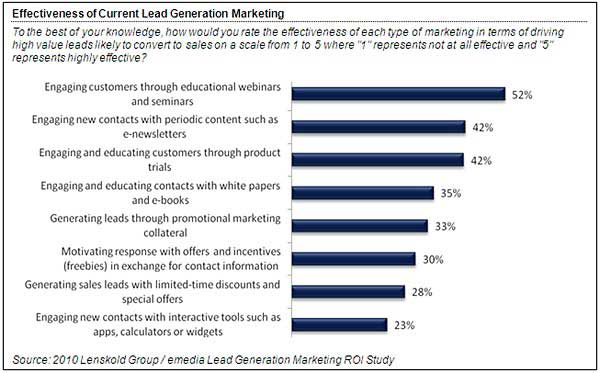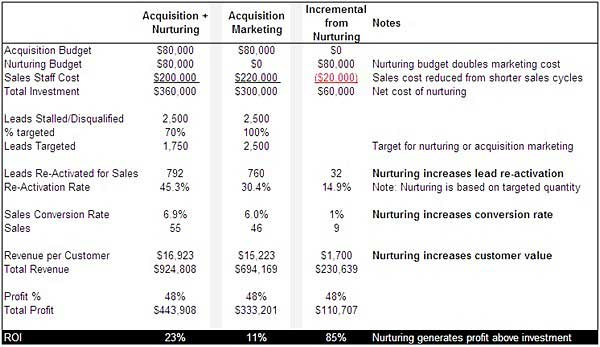Educating and engaging prospects is a significant part of lead-generation marketing.
Online channels have made it easier and less expensive to distribute content in an environment where potential buyers are seeking information and are open to interaction.
Marketing tactics that educate and engage prospects are useful in the early stages of the customer-purchase funnel to build awareness and interest, and in the middle of the funnel to generate leads. Such tactics are also valuable in nurturing stalled leads—interested prospects who are not yet ready to buy.
According to the 2010 Lead Generation Marketing ROI Study by the Lenskold Group/eMedia, lead-generation marketers said the area of marketing that is most underfunded relative to the potential value it can provide is stalled leads.
Lead nurturing has high potential value when your acquisition programs have generated responses from interested prospects who are not yet ready to buy. Such stalled leads within the sales organization will typically get the periodic call with the "Are you ready to buy yet?" message. In the absence of a lead-nurturing program, the marketing organization may toss the leads back into the prospect pool and let future acquisition marketing bring them back into the lead/sales process.
It's easy to see why marketers believe there is high profit potential there—with low-cost marketing contacts targeting the right leads that are not fully qualified or stalled in the sales pipeline, educating and engaging those prospects can increase conversion rates, increase the value per customer, and shorten the sales cycle.
According to the 2010 lead generation study, six in 10 lead-generation marketers (58%) agreed that nurturing stalled leads is underfunded in relation to its potential value:

Moreover, marketing tactics that work well to nurture leads by educating and engaging them were ranked highest in effectiveness relative to more sales-oriented tactics. B2B lead-generation marketers rate their effectiveness of the following such tactics as high or very high (4 or 5 on a 5-point rating scale):

Marketers see the value of engaging and educating prospects, as well as establishing lead-nurturing programs to enhance their lead-generation effectiveness, but the approach is much more challenging than acquisition marketing to prove.
Nurturing Objectives and Strategy
To develop a profitable lead-nurturing program, you must align the strategies and objectives to the business outcomes the program is likely to influence. When evaluating a nurturing program against ongoing acquisition marketing without nurturing, nurturing can increase three primary financial outcomes—lead volume, customer value, and conversion rates—and provide an opportunity to decrease costs.
1. Maintain awareness and interest for increased lead volume
The frequent touch points from nurturing marketing, combined with the educational content and engagement opportunities, keep awareness and interest high so that your solution is top of mind as prospects' needs change.
When a program to nurture stalled leads is integrated into acquisition marketing, the lead volume should increase as more prospects contact or accept a contact from sales. A greater volume of qualified leads should result in incremental sales.
2. Condition leads for higher customer value
Without a nurturing program in place, another acquisition program may eventually capture a stalled lead who eventually becomes ready to buy.
Tactics such as newsletter articles, blog postings, whitepapers, e-books, and webinars provide quality contacts that go well beyond maintaining awareness. Those marketing initiatives are providing value to the prospect that is relevant to the prospect's needs, providing how-to's, case studies, deeper insights into potential uses of your products, and expert opinions on your solution.
Prospects who re-enter the sales cycle after a period of nurturing should have increased customer value from a higher propensity to purchase higher-level solutions, higher purchase volumes, and longer tenure as a customer.
3. Increasing conversion rates with shorter sales cycles
The educational benefits referenced above should increase conversion rates in addition to customer value. Part of the direct sales relationship consists of educating prospects on their options. Better-educated prospects should therefore move through the sales cycle faster, and with improved close rates.
Shorter sales cycles have benefits beyond financial contribution, such as higher close rates and improved management of monthly or quarterly goals.
Targeting to Nurture High-Potential Segments
Many online-based nurturing programs have a low "variable" cost, meaning that once you establish a newsletter, webinar, or whitepaper, the cost of adding both high-potential and low-potential prospects is so minimal, it makes you wonder why targeting is important.
But low-potential prospects are expected to eventually generate leads to hand off to the sales organization. Leads likely to have low value or low potential to convert will start consuming more-valuable resources in the sales cycle without providing much payback.
That is not to suggest that you chase low-potential prospects out of these marketing initiatives but that you be selective in the leads that are fed into the nurturing program.
Targeting and screening should be managed as follows:
- Marketing-generated/sales-rejected leads. The sales organization will accept a portion of these leads. The balance of the leads that are disqualified by sales should be split into groups that are either qualified for nurturing or not qualified contacts for future marketing and sales activity.
- Stalled leads. Once leads enter the sales pipeline, they will be won (closed sale), lost (no sale), or stalled (no decision or not ready to buy). Stalled leads can become too costly for sales contacts without the benefit of nurturing initiatives that move the contact forward in the purchase funnel. Once again, targeting criteria is necessary to filter out low-value and low-potential leads that do not belong in the nurturing program.
New leads from acquisition marketing are typically qualified and screened prior to the handoff to sales. The same process will work for reactivated leads from nurturing programs to ensure that only high-potential prospects continue into the sales pipeline.
Measuring Lift and ROI
One of the more significant challenges to winning support for lead-nurturing programs is the increased complexity in measurements. Those programs tend to be longer-term and involve a series of marketing investments that may not have an immediate response or lift. A change in the measurement approach can help.
When making your case for a current or new lead-nurturing program, compare it with the business practices for acquisition marketing and sales management without a nurturing program.
The business outcomes of increased leads and sales, higher customer value, and higher conversion rates must be measured over time for the complete nurturing program to which the collective marketing tactics contribute.
Measurements can also assess the contribution of specific marketing initiatives within a nurturing program to ensure that education or engagement is contributing value.
Many of the short-term metrics that marketers use to evaluate educational tactics, such as downloads or event attendance, can work very well as indicator measures.
The indicators can determine where tactics may be weak or strong, but be careful not to let those metrics become the goals. You may have tactics that generate low participation rates but may also have a very strong impact on sales conversion or customer value. Examples of both contribution and indicator metrics and measures are given below.
Metrics and measurements
Program performance contribution measures:
- Incremental sales conversion rate (tracking/analysis of nurtured vs. non-nurtured prospects)
- Incremental customer value (tracking/analysis of nurtured vs. non-nurtured prospects)
- Incremental sales-qualified leads reactivated following stall/drop/disqualification (tracking/analysis of nurtured vs. non-nurtured leads)
- Sales cycle from active lead to conversion (tracking/analysis of nurtured vs. non-nurtured leads)
Tactic performance-indicator measures (short term):
- Purchase-intention ratings (post-tactic survey)
- Brand-preference ratings (post-tactic survey)
- Perceived-value ratings (post-tactic survey)
- Engagement rates, such as whitepaper downloads, newsletter click-throughs, and webinar attendance (tracking)
- Progress on sales-qualification metrics, such as purchase timing, budget, and need (post-tactic surveys and/or sales-qualification contacts)
The performance of specific tactics within a lead-nurturing program can be isolated and measured using either market-testing with control groups to assess the incremental contribution or modeling to identify which tactics are driving improved conversion rates and customer value.
Demonstrating ROI Lift
A basic version of a return on investment (ROI) analysis can show how those key metrics can make the case for lead nurturing, as shown in the example below. In more-advanced versions of this analysis, the assessment could also include more detail on marketing contacts and responses throughout the nurturing period, the sales funnel that leads to the net-conversion rate, and drivers of the sales-staff cost.
The following table compares the total cost and impact of a nurturing program supporting ongoing acquisition marketing with the stalled or disqualified leads against acquisition marketing alone. The difference between the two, shown in the third column, constitutes the incremental impact generated from the lead-nurturing program.

Not all nurturing programs will have an influence on all the profit drivers shown in this example, including reduced sales cost, additional leads, increased conversion rates, and increased customer value.
The step of running a basic ROI analysis will show how much lift is necessary to deliver a profitable nurturing program, which helps to focus strategies and objectives, refine targeting, and establish key metrics for measurement. Preliminary assumptions can be used to build the initial budget request to launch or test a nurturing program.
* * *
Lead nurturing requires a sound strategy that can influence the right profit drivers. Marketers must show that nurturing those leads that have the potential to convert into high-value customers is worth the extra effort and expense over ongoing acquisition marketing.
Marketing tactics must align to the business outcomes so that educational marketing is contributing to higher customer value and conversion rates. With an ROI analysis and quality measurements in place, marketers can develop and deliver highly effective and efficient lead-nurturing programs.




